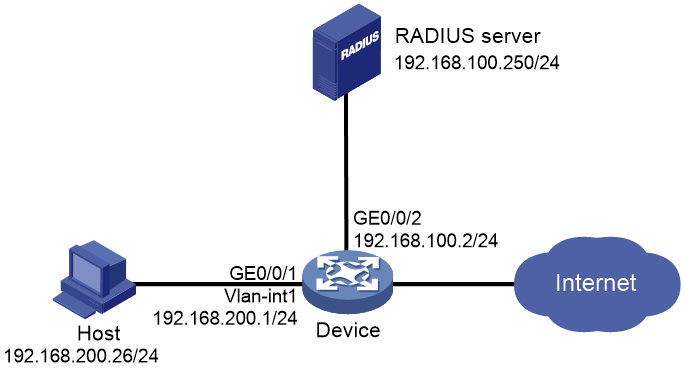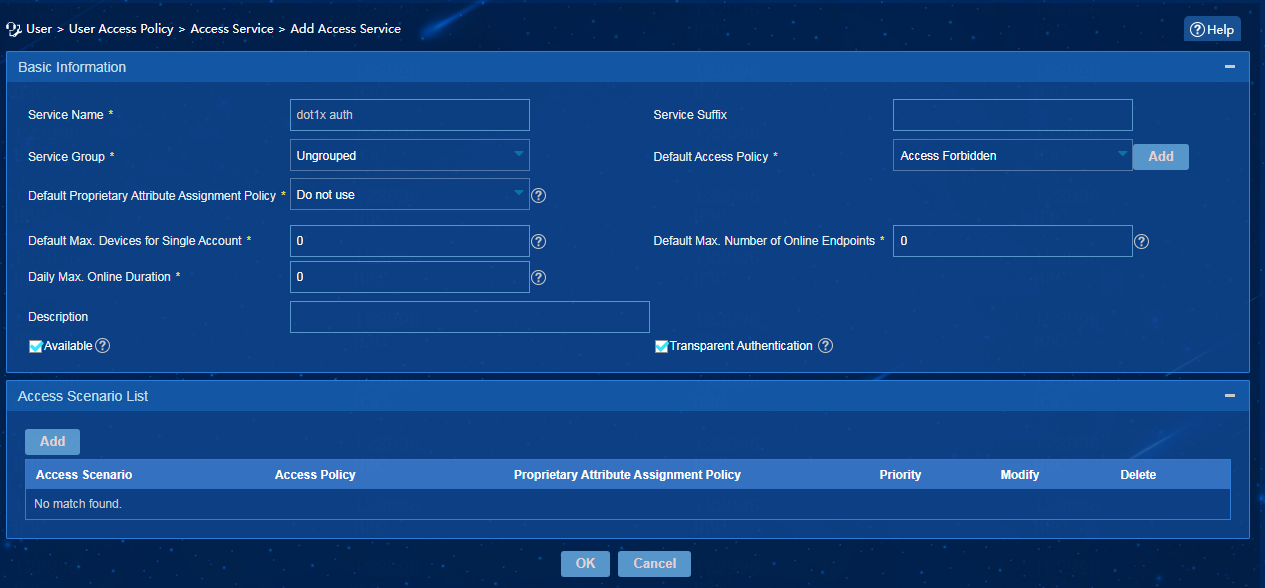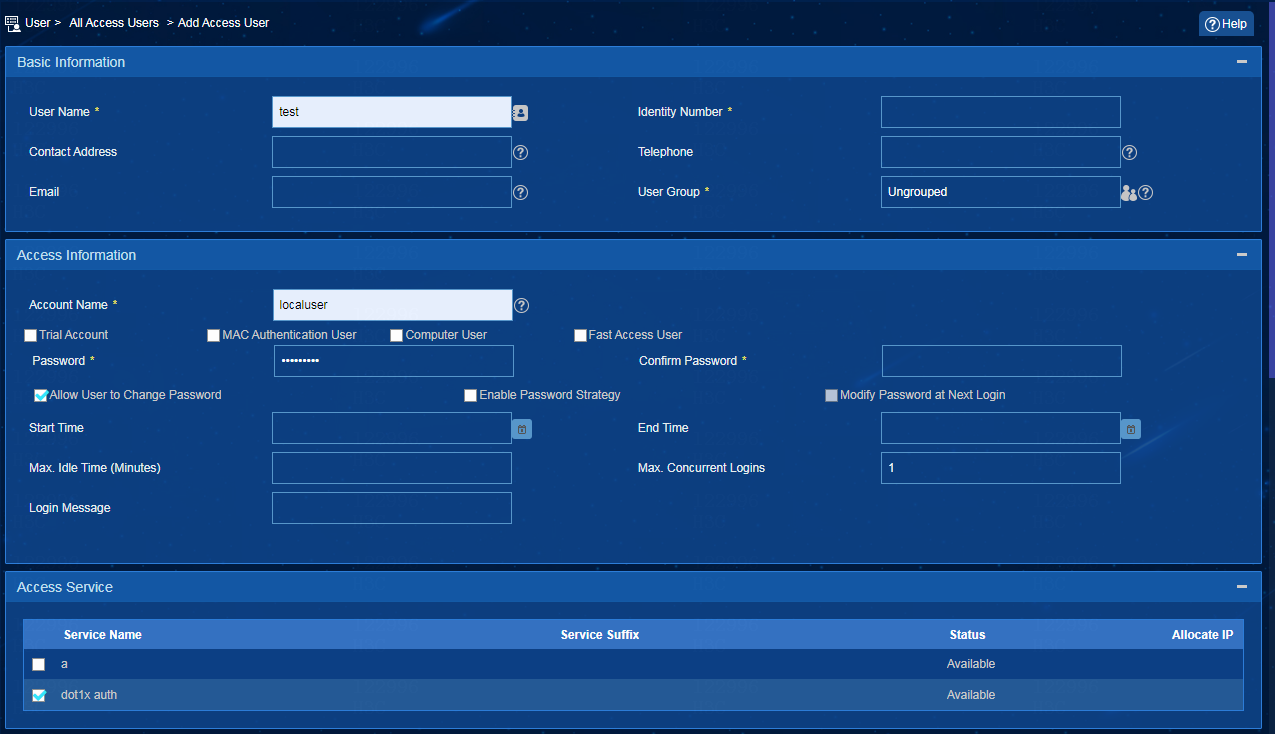- Table of Contents
-
- H3C MSR1000[2600][3600] Routers Configuration Examples All-in-One-R9141-6W100
- 00-Preface
- 01-Local 802.1X Authentication Configuration Examples
- 02-RADIUS-Based 802.1X Authentication Configuration Examples
- 03-AAA Configuration Examples
- 04-ACL Configuration Examples
- 05-MPLS over ADVPN Configuration Examples
- 06-ARP Attack Protection Configuration Examples
- 07-BFD Configuration Examples
- 08-Basic BGP Configuration Examples
- 09-BGP Route Attribute-Based Route Selection Configuration Examples
- 10-EAA Monitor Policy Configuration Examples
- 11-GRE with OSPF Configuration Examples
- 12-HoVPN Configuration Examples
- 13-IGMP Snooping Configuration Examples
- 14-IGMP Configuration Examples
- 15-IPsec Configuration Examples
- 16-IPsec Digital Certificate Authentication Configuration Examples
- 17-IPv6 IS-IS Configuration Examples
- 18-IPv6 over IPv4 GRE Tunnel Configuration Examples
- 19-IPv6 over IPv4 Manual Tunnel with OSPFv3 Configuration Examples
- 20-IS-IS Configuration Examples
- 21-Combined ISATAP Tunnel and 6to4 Tunnel Configuration Examples
- 22-L2TP over IPsec Configuration Examples
- 23-Multi-Instance L2TP Configuration Examples
- 24-L2TP Multidomain Access Configuration Examples
- 25-MPLS L3VPN Configuration Examples
- 26-MPLS OAM Configuration Examples
- 27-MPLS TE Configuration Examples
- 28-Basic MPLS Configuration Examples
- 29-NAT DNS Mapping Configuration Examples
- 30-NetStream Configuration Examples
- 31-NQA Configuration Examples
- 32-NTP Configuration Examples
- 33-OSPFv3 Configuration Examples
- 34-OSPF Configuration Examples
- 35-OSPF Multi-Process Configuration Examples
- 36-OSPF Multi-Instance Configuration Examples
- 37-Portal Configuration Examples
- 38-PPP Configuration Examples
- 39-RBAC Configuration Examples
- 40-RMON Configuration Examples
- 41-IPv4 NetStream Sampling Configuration Examples
- 42-SNMP Configuration Examples
- 43-SRv6 Configuration Examples
- 44-SSH Configuration Examples
- 45-Tcl Commands Configuration Examples
- 46-VLAN Configuration Examples
- 47-VRRP Configuration Examples
- 48-VXLAN over IPsec Configuration Examples
- 49-WLAN AC Configuration Examples
- 50-Small and Medium-Sized Store Configuration Examples
- 51-Cloudnet VPN Configuration Examples
- 52-Ethernet Link Aggregation Configuration Examples
- 53-Ethernet OAM Configuration Examples
- 54-Outbound Bidirectional NAT Configuration Examples
- 55-NAT Hairpin in C-S Mode Configuration Examples
- 56-Load Sharing NAT Server Configuration Examples
- 57-BIDIR-PIM Configuration Examples
- 58-Control Plane-Based QoS Policy Configuration Examples
- 59-Scheduling a Task Configuration Examples
- 60-Client-Initiated L2TP Tunnel Configuration Examples
- 61-LAC-Auto-Initiated L2TP Tunnel Configuration Examples
- 62-Authorized ARP Configuration Examples
- 63-GTS Configuration Examples
- 64-Traffic Policing Configuration Examples
- 65-Traffic Accounting Configuration Examples
- 66-Mobile Communication Modem Management Configuration Examples
- 67-Port Isolation Configuration Examples
- 68-PBR Configuration Examples
- 69-TFTP Client Software Upgrade Configuration Examples
- 70-FTP Client Software Upgrade Configuration Examples
- 71-FTP Server Software Upgrade Configuration Examples
- 72-Routing Policy Configuration Examples
- 73-Software Upgrade from the BootWare Menu Configuration Examples
- 74-Mirroring Configuration Examples
- Related Documents
-
| Title | Size | Download |
|---|---|---|
| 02-RADIUS-Based 802.1X Authentication Configuration Examples | 591.74 KB |
RADIUS-Based 802.1X Authentication Configuration Examples
Copyright © 2024 New H3C Technologies Co., Ltd. All rights reserved.
No part of this manual may be reproduced or transmitted in any form or by any means without prior written consent of New H3C Technologies Co., Ltd.
Except for the trademarks of New H3C Technologies Co., Ltd., any trademarks that may be mentioned in this document are the property of their respective owners.
The information in this document is subject to change without notice.
Introduction
The following information provides an example for configuring RADIUS-based 802.1X authentication.
Prerequisites
The following information applies to Comware 9-based routers. Procedures and information in the examples might be slightly different depending on the software or hardware version of the routers.
The configuration examples were created and verified in a lab environment, and all the devices were started with the factory default configuration. When you are working on a live network, make sure you understand the potential impact of every command on your network.
The following information is provided based on the assumption that you have basic knowledge of AAA and 802.1X.
Example: Configuring RADIUS-based 802.1X authentication
Network configuration
As shown in Figure 1, the router works together with the RADIUS server to perform 802.1X authentication for users connected to GigabitEthernet 0/0/1. Configure the network to meet the following requirements:
· Configure the router to exclude the domain names from the usernames sent to the RADIUS server.
· Set the username to localuser.
· Use the IMC server as the RADIUS server to perform authentication and accounting for users, and configure local authentication as the secondary authentication method when RADIUS authentication fails.
· Implement port-based access and specify mandatory 802.1X authentication domain bbb on the port.
Software versions used
This configuration example was created and verified on R9141P16 of the MSR2630E-X1 device.
Restrictions and guidelines
When you configure RADIUS-based 802.1X authentication, follow these restrictions and guidelines:
· This example can be implemented on only devices installed with Layer 2 switching cards and having fixed Layer 2 interfaces.
· Make sure the parameters (such as shared keys, authentication ports, and accounting ports) configured on the router and the RADIUS server are the same.
Procedures
Configuring the RADIUS server
Add an access device
1. Log in to IMC and click the User tab.
2. From the navigation pane, select User Access Policy > Access Device Management > Access Device.
3. Click Add.
4. On the page that opens, configure the following parameters:
¡ Set the authentication port and accounting port to 1812 and 1813, respectively.
¡ Select H3C (General) from the Access Device Type list.
¡ Set the shared key to name for secure communication with the device and confirm the shared key.
¡ Select an access device from the device list or manually add an access device. In this example, the device IP address is 192.168.100.2.
¡ Use the default settings for other parameters, and then click OK.
Figure 2 Adding an access device
Adding an access service
1. Click the User tab.
2. From the navigation pane, select User Access Policy > Access Service.
3. Click Add.
4. On the page that opens, configure the following parameters:
¡ Enter access service name dot1x auth.
¡ Use the default settings for other parameters, and then click OK.
Figure 3 Adding an access service
Adding an access user
1. Click the User tab.
2. From the navigation pane, select Access User > All Access Users.
3. Click Add.
The Add Access User page opens.
4. In the Access Information area, click the Add User button for the User Name field.
5. On the page that opens, configure the following parameters:
¡ Enter test in the User Name field.
¡ Enter account name localuser and set the password to localpass.
¡ Select dot1x auth in the Access Service area.
Figure 4 Adding an access user
Configure the router
# Create VLAN-interface 1, and assign an IP address to it.
[Router] interface vlan-interface 1
[Router-Vlan-interface1] ip address 192.168.200.1 255.255.255.0
[Router-Vlan-interface1] quit
# Configure an IP address for GigabitEthernet 0/0/2.
[Router] interface gigabitethernet 0/0/2
[Router-GigabitEthernet0/0/2] ip address 192.168.100.2 255.255.255.0
[Router-GigabitEthernet0/0/2] quit
# Create a network access user named localuser and set the password to localpass in plaintext form.
[Router] local-user localuser class network
[Router-luser-network-localuser] password simple localpass
# Set the service type to lan-access.
[Router-luser-network-localuser] service-type lan-access
[Router-luser-network-localuser] quit
# Create a RADIUS scheme named radius1 and enter its view.
[Router] radius scheme radius1
# Configure the primary authentication server. Set its IP address to 192.168.100.250, port number to 1812, and shared key to name.
[Router-radius-radius1] primary authentication 192.168.100.250 1812 key simple name
# Configure the primary accounting server. Set its IP address to 192.168.100.250, port number to 1813, and shared key to name.
[Router-radius-radius1] primary accounting 192.168.100.250 1813 key simple name
# Exclude the domain names from the usernames sent to the RADIUS server.
[Router-radius-radius1] user-name-format without-domain
[Router-radius-radius1] quit
# Create an ISP domain named bbb and configure the authentication, authorization, and accounting methods for login users.
[Router-isp-bbb] authentication lan-access radius-scheme radius1 local
[Router-isp-bbb] authorization lan-access radius-scheme radius1 local
[Router-isp-bbb] accounting lan-access radius-scheme radius1 local
[Router-isp-bbb] quit
# Enable 802.1X on GigabitEthernet 0/0/1.
[Router] interface gigabitethernet 0/0/1
[Router-GigabitEthernet0/0/1] dot1x
# Enable port-based access control and specify mandatory 802.1X authentication domain bbb on the port. By default, the port uses MAC-based access control.
[Router-GigabitEthernet0/0/1] dot1x port-method portbased
[Router-GigabitEthernet0/0/1] dot1x mandatory-domain bbb
[Router-GigabitEthernet0/0/1] quit
# Enable 802.1X globally.
<Router> system-view
[Router] dot1x
Verifying the configuration
# Use the display dot1x interface command to view 802.1X information on GigabitEthernet 0/0/1.
[Router] display dot1x interface gigabitethernet 0/0/1
Global 802.1X parameters:
802.1X authentication : Enabled
CHAP authentication : Enabled
Max-tx period : 30 s
Handshake period : 15 s
Quiet timer : Disabled
Quiet period : 60 s
Supp timeout : 30 s
Server timeout : 100 s
Reauth period : 3600 s
Max auth requests : 2
SmartOn supp timeout : 30 s
SmartOn retry counts : 3
EAD assistant function : Disabled
EAD timeout : 30 min
Domain delimiter : @
Online 802.1X wired users : 0
Online 802.1X wireless users : 0
GigabitEthernet0/0/1 is link-up
802.1X authentication : Enabled
Handshake : Enabled
Handshake reply : Disabled
Handshake security : Disabled
Unicast trigger : Disabled
Periodic reauth : Disabled
Port role : Authenticator
Authorization mode : Auto
Port access control : Port-based
Multicast trigger : Enabled
Mandatory auth domain : bbb
Guest VLAN : Not configured
Auth-Fail VLAN : Not configured
Critical VLAN : Not configured
Critical voice VLAN : Disabled
Re-auth server-unreachable : Logoff
Max online users : 4294967295
SmartOn : Disabled
EAPOL packets: Tx 39, Rx 2
Sent EAP Request/Identity packets : 39
EAP Request/Challenge packets: 0
EAP Success packets: 0
EAP Failure packets: 0
EAP Notification packets: 0
Received EAPOL Start packets : 1
EAPOL LogOff packets: 1
EAP Response/Identity packets : 0
EAP Response/Challenge packets: 0
Error packets: 0
Online 802.1X users: 0
# Execute the display dot1x sessions command to verify that you can come online after entering the correct username and password.
# Disconnect the device from the RADIUS server. Verify that you can still come online after entering the username and password.
Configuration files
#
dot1x
#
interface Vlan-interface1
ip address 192.168.200.1 255.255.255.0
#
interface GigabitEthernet0/0/1
port link-mode bridge
dot1x mandatory-domain bbb
dot1x port-method portbased
dot1x
#
interface GigabitEthernet0/0/2
port link-mode route
ip address 192.168.100.2 255.255.255.0
#
radius scheme radius1
primary authentication 192.168.100.250 key cipher $c$3$Ua8m/JVT48sS4hXncslGCkRa
VEbAbk
primary accounting 192.168.100.250 key cipher $c$3$x0HaZfI2XD6iXBE5E/zTEgEopD8C
eyI=
user-name-format without-domain
#
domain bbb
authentication lan-access radius-scheme radius1 local
authorization lan-access radius-scheme radius1 local
accounting lan-access radius-scheme radius1 local
#
local-user localuser class network
password cipher $c$3$TFxtbGxKPAxP3LUXfHeUuky7uuaBi9jAmoCnWA==
service-type lan-access
authorization-attribute user-role network-operator
#
Related documentation
· User Access and Authentication Configuration Guide in H3C MSR1000[2600][3600] Routers Configuration Guides(V9)
· User Access and Authentication Command Reference in H3C MSR1000[2600][3600] Routers Command References(V9)




